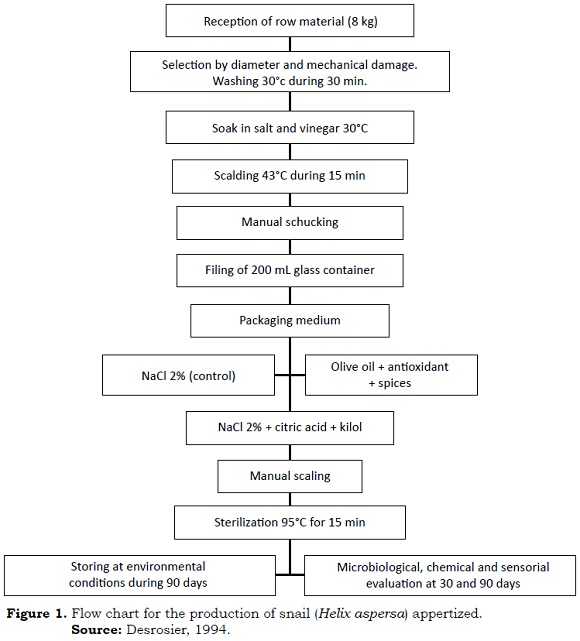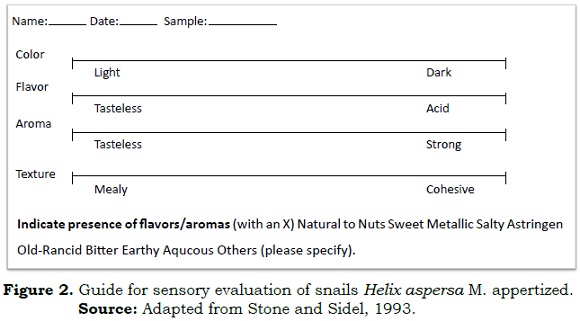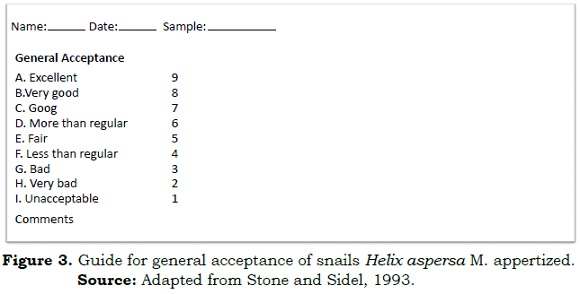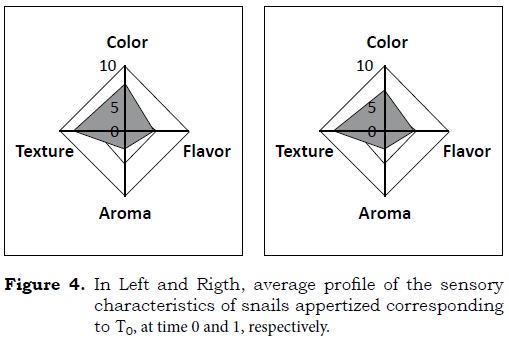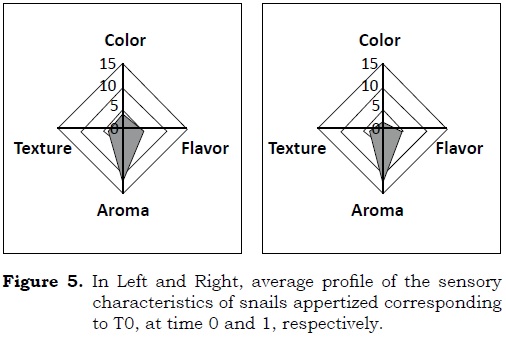Services on Demand
Journal
Article
Indicators
-
 Cited by SciELO
Cited by SciELO -
 Access statistics
Access statistics
Related links
-
 Cited by Google
Cited by Google -
 Similars in
SciELO
Similars in
SciELO -
 Similars in Google
Similars in Google
Share
Acta Agronómica
Print version ISSN 0120-2812
Acta Agron. vol.64 no.1 Palmira Jan./June 2015
https://doi.org/10.15446/acag.v64n1.38809
Agroindustria doi: http://dx.doi.org/10.15446/acag.v64n1.38809 e-ISSN 2323-0118
Preparation and evaluation of appertized from snail Helix aspersa M.
Preparación y evaluación de apertizado elaborado con caracol Helix aspersa M.
Nelson Loyola López*, Gladys Moraga Recabal y Carlos Acuña Carrasco.
University of Maule. Faculty of Agricultural and Forestry Sciences, Department of Agricultural Sciences. Carmen 684 Casilla 7-D Curico, Chile. *Author for correspondence: nloyola@ucm.cl
Rec.: 30.10.2013 Acep.: 21.02.2014
Abstract
This study includes the development and evaluation of snails (Helix aspersa M.) appertized, collected at a heliciculture breeding center, located in Los Niches sector, Curico, Maule region, South-central of Chile. The test was conducted at the Laboratory of Sciences of the Catholic University of Maule, Nuestra Señora del Carmen Campus, Curico. The main objective of this work was to study the influence of appertized on sensory attributes and commercial durability of snail Helix aspersa M. Additionally, some specific objectives were proposed as follow: to provide this mollusc with a commercial alternative for it consume, to evaluate its organoleptic characteristics and guarantee the product from both the microbiological and nutritional points of view. Three media cover were used (T0: water + NaCl 2%; T1: Water + NaCl 2% + citric acid 0.5% + kilol and T2: extra virgin olive oil + spices + tocopherol). The product was assessed at two different times, after 30 and 90 days of storage. Two sensory evaluations were conducted to measure various organoleptic attributes and acceptability of the appertized by 14 trained panelists. Amino acid, vitamins, cholesterol, acidity, heavy metals, phosphorus and organochlorines analysis were performed. The presence of both total and fecal contaminant microorganisms was determined. Attributes such as color, flavor, aroma, texture and overall acceptability were also measured. Preserves made by T0 and T1 treatments were equally accepted by the panelists. However, preserve from treatment T2 was rejected because of the detection in them of a very dark color, odor and mealy texture. Positive results regarding the content of amino acids, vitamin C and low cholesterol, as well as the absence of pathogenic microorganisms were obtained for the three treatments.
Key words: Helix aspersa M., appertized, microbiological, sensory and chemical evaluation.
Resumen
En el Laboratorio de Ciencias de la Universidad Católica del Maule, Campus Nuestra Señora del Carmen, Curicó, Chile, se elaboraron y evaluaron apertizados de caracoles (Helix aspersa M.), adquiridos en un plantel de helicicultura ubicado en el sector Los Niches. El objetivo general fue evaluar la influencia del apertizado en los atributos sensoriales y durabilidad comercial de los caracoles. Como objetivos específicos se planteó otorgar a este molusco una alternativa comercial de consumo, evaluar sus características organolépticas y garantizar el producto desde el punto de vista microbiológico y nutritivo. Para ello se utilizaron tres medios de cobertura (T0: agua + NaCl al 2%; T1: agua + NaCl al 2% + ácido cítrico 0,5% + kilol y T2: aceite de oliva extra virgen + tocoferol + especias) y dos tiempos de evaluación, después de 30 y 90 días de almacenamiento. Se realizaron, además, dos evaluaciones sensoriales para medir diferentes atributos organolépticos y la aceptabilidad del antipasto por parte de 14 panelistas entrenados. Se realizaron análisis de aminoácidos, vitaminas, colesterol, acidez, metales pesados, órgano-clorados y fosforados. Desde el punto de vista microbiológico se determinó la presencia de microorganismos totales y fecales contaminantes. En la evaluación sensorial se midieron los atributos de color, sabor, aroma, textura y aceptabilidad general. Los resultados mostraron que conservas elaboradas según los tratamientos T0 y T1 fueron igualmente aceptadas por los panelistas, por el contrario, conservas con el tratamiento T2 fueron rechazadas, ya que se detectaron en ellas color muy oscuro, olor desagradable y textura harinosa. Además, se presentaron resultados positivos en los tres tratamientos con respecto al contenido de aminoácidos, vitamina C y bajo colesterol, así como también la ausencia total de microorganismos patógenos.
Palabras clave: Helix aspersa M., apertizados, evaluación química, microbiológica y sensorial.
Introduction
Chile has very favorable conditions for snail breeding for instance the climate is mild temperate which facilitates reproduction over a longer period of the year, compared with Europe, where long cold winters cause the animal to stay longer in hibernation, which is the reason behind the production under controlled environments, meaning higher costs of production (Daguzan, 1989). According to Bazán (2005) in recent years there has been a milestone in the history of national heliciculture, as it was completed the first export of live operculated snail, raised under intensive system, whose final destination was Spain. In the field of so-called exotic meats, terrestrial snails represent a large potential market, since their meat is low in fat, its amino acid content is important, its cholesterol level is probably low and mainly because it is a development alternative for the small entrepreneur, who could diversify its products (Martínez and Ballester, 2005). The conservation of this mollusk through an appertized, together its sensory, nutritional and security evaluation, would allow the potential buyer to be sure of what is being bought and to appreciate its organoleptic characteristics after long storage period (Corfo, 1990; Achipia, 2014a). In Chile, the information on physico-chemical, microbiological and organoleptics for the crude product as well as for the appertized, using tinbased containers, is scarce and fragmented (Schmidt-Hebbel and Pennacchiotti, 1985). Therefore, in 1997 was born the food sanitary regulation in Chile which is also used by appertized products such us of the present research to support the sanitary condition of the final product elaborate (Achipia, 2014 b). This study, hypothesized that: the appertizing process would contribute to optimize the organoleptic characteristics and acceptability of snails Helix aspersa M.
The general objective in the present research was to evaluate the influence of appertizing on the sensory attributes and commercial durability of snails (Helix aspersa M.) for human consumption. To support the hypothesis and the general objectives it was developed the following specific objectives, to evaluate the organoleptic characteristics and acceptability of the mollusk, through appertizing. Besides to guarantee from the microbiological and nutritional points of view the consumption of appertizing snails.
Materials and methods
Raw material (Helix aspersa M.) was provided by a heliciculture breeding center, located on the way to Rauco, in the province of Curico, Maule Region VII (34° 55' 36.66" South Latitude and 71° 17' 04.95" West Longitude), about 20 km west of Curico City, which has about 20,000 mollusks, with September and April the months for breeding them and June the harvest time to supply this investigation (M.O.P., 2007). This center has an intensive breeding system with a complete life cycle, protected under greenhouse, with humidity control from 80% to 95%, maintaining temperature between 18°C to 21°C and balanced diet based on wheat flour, chickpea and calcium 95% purity. For the preparation of conservate or appertized, 200 mL glass containers were used with a net weight of 125 g. A completely randomized design in blocks and the experimental unit was the 15 units of snail in a 200 mL bottle. It was applied three treatments with three replication and also for chemical, microbiology and sensory evaluations were used snails samples from four bottles plus three replication. The results obtained were subjected to analysis of variance (Anova) and where significant differences were detected, a multiple range Tuckey test, with a significance level of 5%,was performed (Little and Hills, 1998) (Table 1). After the conserved product was stabilized, i.e. at 30 and 90 days of storage in the warehouse, chemical, microbiological (presence of Escherichia coli) and sensory evaluations were made (Figure 1 and Table 2).
Sensory evaluations were conducted with the participation of 14 panelists, who were properly trained prior to the analysis, according to the assessment guides used (Figure 2 and Figure 3). The panelists abstained from smoking, eating and drinking one hour before tasting. Furthermore, they rinsed their mouth between the tasting of each sample, to avoid confusion later (Stone and Sidel, 1993). The test was applied by researchers who at random selected samples with different treatments, offering the attributes measured such as; aroma, color, flavor and texture in non-structured records, besides appearance and general acceptability of the snails, using a structured- type record in this case (Witting, 2001).
Guide for sensory evaluation of snails appertized. You have been selected to participate in the sensory evaluation of snail appertized, product about to hit the market. You will receive a sample of the product and your opinion is sought according to the sensory evaluation sheet attached. You are asked to mark with a vertical cross over 13 cm line in each parameter, depending on the degree of perceived intensity from low to intense, from left to right, respectively.
Guide for general acceptance of snails appertized. You have been selected to participate in the sensory evaluation of snail appertized, product about to hit the market. You will receive a sample of the product and your opinion is sought according to the sensory evaluation sheet attached. Circle the score indicating its acceptability, according to a 1 - 9 scale, corresponding to the indicated grades from unacceptable to excellent, respectively.
Results and discussion
Microbiological evaluations
The absence of total coliforms and fecal contaminants was confirmed for the three treatments of snails appertized, both after 30 days, considered time 0 in storage and at 90 days considered time 1. The absence of thermophilic and mesophilic microorganisms, both the Clostridium sp. and coliform Enterobacteriaceae family, which includes the species Escherichia coli, showed that appertized products prepared according to the methodology of this study is commercially sterile and could be marketed without undergoing any alteration of microbial origin (Table 3). These results were according to the chilean food microbiology regulation (Reglamento Sanitario de los Alimentos, 1996) which must be considered before the consumer may include it in their normal diet. In this same sense the results obtained in this essay were positive related with the issues of the Codex Alimentarius (2003) and FAO and OMS (1983). Present research supports the previously mentioned authors because they are references in food safety related with molluscs and fish as well as well hygienic practices in the food industry.
In 1973, the Food and Drug Administration (FDA) required HACCP controls for conserved foods with low acid to prevent botulism problems in the population, due to C. botulinum, concluding on the need for reviewing its current program to regulate food safety, in order to replace it with a preventive HACCP system, as it does with seafood (FAO, 1996). The results obtained in the microbiological evaluation, allowed to verify the effectiveness of the procedures used for cleaning and disinfection during the development of this study, also checked that the temperatures used in the process were appropriate.
Chemical evaluations
Regarding the content of amino acids, it was noted the presence of most of the essential amino acids such as isoleucine, phenylalanine, leucine, lysine, methionine, threonine and tryptophan in the three treatments. Cholesterol content, acidity and vitamin C, is shown in (Table 4 and Table 5). According to Bazán (2005) snail meat has low levels of cholesterol and fat, 10 g of meat have 10 mg of cholesterol. The limit of cholesterol in foods should be between 140 mg/dL and 250 mg/ dL (FAO, 1997).
The results obtained for the three treatments of the present study showed a content below the limit, being even more pronounced in treatments T0 and T1. With respect the presence of vitamin C in snail meat, the recommended daily allowance is 60 mg to maintain a total body of a gram and a half. When food is packaged or conserved, it often contains residual oxygen which can react with the food and cause rancidity, loss of color, among others, but the natural or added vitamin C, is responsible for fixing or removing this oxygen (INTA, 1993; Festy, 2007; Challem y Block, 2008). Results from the determination of heavy metals, lead (Pb), arsenic (As), antimony (Sb) and tin (Sn), in addition, organochlorine and organophosphorus are shown in Table 6.
Appertized under the three treatments showed a low content of heavy metals and it was not detected in them the existence of organochlorines and phosphorus, which is of great importance to the future health of consumers, as these compounds can become serious contaminants.
The maximum lead content in food is regulated by the Regulation 466/2001 of FAO Council (1997) and the limits are set for products such as milk 0.2 mg/day, meat supply 0.1 mg/day, fats and oils 0.1 mg/day, bivalves molluscs1.5 mg/day and between 0.05 mg/day and 0.2 mg/day for vegetables (FAO, 1997). Regarding arsenic, this element may be carcinogenic in humans and under current legislation, the maximum level of arsenic in the manufacture of animal food is 2 mg/kg to 4 mg/kg and in the case of feed is 1 mg/kg to 4 mg/kg (FAO, 1997).
According to Gallo (2002) studies involving the soft body of the snail for the determination of oligoelements in the specie H. aspersa, showed traces content in relation to elements lead and tin. This coincides with the results obtained in the present study in which the amount of lead was less than 0.01 mg/kg and tin less than 0.05 mg/kg in appertized under the three treatments T0, T1 and T2.
In general, all the results from chemical evaluations conducted in each of the treatments, allowed to corroborate the results from other studies that positioned the terrestrial snail meat among the best food in terms of quality and nutrition. According to Bazán (2005) the features found in the flesh of these mollusks is mediated by the transformation of plant proteins into animal protein of high both biological and gastronomical quality.
Sensory evaluations
Results at time 0, equivalent to 30 days of storage and time 1, at 90 days of storage, are presented in Tables 7 and 8, respectively.
Color. The results of analysis of variance calculated for the attribute color, showed that in both storage times there were statistically significant differences between treatments T0, T1 and T2, and Tukey test determined that the T1 treatment differed from the rest. The statistical difference of T1, is provoked by a higher score given by the panelists in the sensory evaluation sheet with respect to the perceived intensity of this attribute. The panelists felt that snails under T1 treatment showed a lighter color which contrasted with darker color for T0 and T2.
Color results presented by T1 is justified by the presence of ingredients as kilol and citric acid in this treatment (Table 7). Kilol, which possesses antioxidant activity, helps maintain the organoleptic characteristics, conservation and/or stability of the food, does not alter the food nutritional value, protects from protein degradation, prevents oxidation of lipids, among others. This product is used in the food industry, since it is a seed extract (80%) and pulp (20%) of orange and composed of other natural elements, ascorbic acid (vitamin C), glycerides, tocopherols, aminoacids and other non-toxic, being currently the most widely used preservative in the food industry for salmon in Chile (ISP, 1998). Meanwhile citric acid in packed pork meat, stabilizes the color; additionally, for the case of bacon and cured meats, it promotes the appearance of color and prevents black spots on shrimp (ISP, 1998).
Taste. Scores given by the panelists with respect the intensity perception for this attribute was similar for each treatment. They considered that for snails from T0, T1 and T2 the trend showed bland flavor. The ingredients used in the manufacture of each conservated food or treatment had no significant impact on the flavor of the snails (Table 8). Only some panelists, in the comments and observations of the evaluation sheet, showed that those with T2 treatment presented a flavor similar to olives. This last, because one of the ingredients of T2 was extra virgin olive oil. The extra virgin olive oil (oleic acid does not exceed 1 g/100g) containing mainly glycerides composed by a mixture of saturated and unsaturated fatty acids, the unsaturation is mainly due to oleic acid content between 67% and 83%, and only about 2% is fully unsaturated (Desrosier, 1994).
Aroma. According to the evaluation of the panelists, preserves under T2 treatment had a higher score. They perceived, in this treatment, a sensory attribute intensity as highly strong smell and unpleasant. Different was the assessment for preserves with T0 and T1, which were evaluated with a bland and pleasant aroma, similar to freshly prepared snail. The big difference in the content of T2 relative to T0 and T1 was the use of extra virgin olive oil as a medium of cover, also the antioxidant tocopherol and some spices were added. Perhaps the negative result in the attribute aroma, was as a result of deterioration or decomposition of olive oil, after being subjected to high temperatures for sterilizing the appertized. When oxidation is the main problem in the deterioration of the oil, the amount of oil that undergoes these changes may be small, but resulting odors are strong, very sharp and out of proportion to the volume of oil damaged (Desrosier, 1994).
Texture. According to the evaluation given to the three treatments by the panelists, preserves under T2 treatment received the lowest score regarding the texture attribute. According to the panelists, snails texture for T2 treatment was described as mealy. Different evaluation received treatments T0 and T1 in which the texture achieved higher values, being more cohesive and described as similar to the original texture of the mollusk (Table 8). The negative results for T2 for this sensory attribute, are due to oxidation and decomposition of the olive oil. According Desrosier (1994) oxidation can influence the texture resulting in product viscosity. In relation to the generally accepted treatment, preserves made as T0 and T1, were similarly accepted by the panelists. Preserves from treatment T2 were rejected, as very dark color, odor and mealy texture were detected on them. The general acceptance of snails with treatments, T0 and T1 by the panelists, is justified by the positive results of these two treatments presented in the evaluation of sensory attributes, flavor, aroma and texture and the color, especially in T1.
Figure 4 and Figure 5 show different sensory profiles from the evaluated snails appertized (T0, T1 and T2). In Figure 4, it can be seen that for both evaluation times, 30 and 90 days of storage, for treatment with snails under T0, the perceived quality attribute with a higher degree of intensity by the panelists was the texture. The attributes, flavor, aroma and color were perceived at a lower intensity than texture, but similar between them.
Regarding preserves in treatment T1, quality attributes perceived with greater intensity by the panelists were texture and color. The two remaining attributes, flavor and aroma, were perceived at a lower intensity. Mollusks in treatment T1 were those with the highest widespread acceptance and also the best evaluation of all quality parameters present in the evaluation guide used by the panelists. In studies on preserved snails, it was concluded that the addition of additives such as citric acid 0.03% during the precooking stage provoked good results in texture and appearance of the product (Corfo, 1990). Figure 5 shows the sensory profile of snails with treatment T2, showing that in both evaluation times the aroma attribute was perceived with a greater degree of intensity, but in this case, negatively evaluated by the panelists as, 'strong and unpleasant'. Appertized preparations with this treatment were rejected by the panelists. It can be said, that according to the responses obtained in the two evaluation guides used for the sensory evaluation and analysis of data, only the T0 and T1 treatments are recommended, T2 treatment descarted by the refusal of the panelists. Citric acid was used for T1, proving its efficiency when considering this treatment was the one with the highest acceptance by the panelists.
Conclusions
- The mollusks subjected to treatments T0 (Control: water + NaCl 2%) and T1 (water + 2% NaCl + citric acid + kilol -active ingredient: pomelo grapefruit extract doses of 30 ppm-) were accepted by panelists with positive results in the organoleptic characteristics, freshly prepared snail-like taste, pleasant aroma and firm texture also in the case of T1 a lighter color.
- Appertized under T2 treatment (extra virgin olive oil + antioxidant -active ingredient: tocopherol in doses of 10 ppm-) was rejected by negative results in three of the parameters evaluated, presenting, dark color, unpleasant flavor and mealy texture.
- The three treatments showed positive results regarding the content of amino acids, vitamin C, low cholesterol and heavy metals as well as the total absence of total microorganisms and fecal contaminants.
Acknowledge
This project received internal funding from the Catholic University of Maule (U.C.M.) through the Research Department, which belongs to the Vice Dean of Research and Graduate Studies.
Referencias
Achipia (Agencia Chilena para la Calidad e Inocuidad Alimentaria). 20014a. Código Sanitario (Decreto con fuerza de ley 725 del 31 de Enero de 1968. Available in: www.achipia.cl Consulted: 13/03/2014. [ Links ]
Achipia (Agencia Chilena para la Calidad e Inocuidad Alimentaria). 20014b. Reglamento Sanitario de los Alimentos (Decreto de ley 977 de Mayo de 1997. Available in: www.achipia.cl Consulted: 14/03/2014. [ Links ]
AOAC. (Official Methods of Analysis 985.16). 1990. Association of Official Analytical Chemists. Tin in Canned Foods. Atomic Absorption Spectrophotometric Method, Official Final Action, 1988.AOAC Official Methods of Analysis, 1, (985.16) 270-217, AOAC Arlington, VA. [ Links ]
AOAC (Official Methods of Analysis 988.11). 1992. Official Methods for Chemical elements in food of animal origin. Mercury (Methyl) in fish and shellfish.Rapid Gas Chromatographic Method. 7 p. Available in: <http://www.iss.it/binary/lcdr2/cont/List_Methods.pdf> Consulted: 14/03/2014. [ Links ]
AOAC, 1997. Official Methods of Analysis 994.12. Amino Acid in feeds.Performic acid oxidation with acid hydrolysis - sodium metabisulfite method.11 p. Available in: <http://www.fao.org/fileadmin/user_upload/agns/pdf/CXS_234e.pdf> Consulted: 14/03/2014. [ Links ]
AOAC (Official Methods of Analysis 999.11). 2000. Association of Official Analytical Chemists, 17 th Edition, USA. Available in: <http://www.fao.org/fileadmin/user_upload/agns/pdf/CXS_234e.pdf> Consulted 14/03/2014. [ Links ]
AOAC (Official Methods of Analysis 939.05). 2000. Determining titratable acidity. Available in: <http://www.fao.org/fileadmin/user_upload/agns/pdf/CXS_234e.pdf> Consulted 14 03 2014. [ Links ]
AOAC (Official Methods of Analysis 967.21). 2000. Recommended methods of analysis and sampling. 48 p. Available in: <http://www.fao.org/fileadmin/user_upload/agns/pdf/CXS_234e.pdf> Consulted: 14/03/2014. [ Links ]
AOAC (Official Methods of Analysis 966.24). 2000. Instructivo técnico para recuento de Escherichia coli mediante método tradicional de cultivo. 14 p. Available in: <http://www.sag.cl/sites/default/files/it-lab-17-v02.pdf> Consulted : 14/03/2014. [ Links ]
AOAC (Official Methods of Analysis 991.14 ó 998.08). 2000. Placa Petrifilm® Recuento de Escherichia coli y coliformes en alimentos. (método de film seco rehidratable). 10 p. Available in: <http://webdesa.sag.gob.cl/sites/default/files/8_INSTRUC_TEC_RECUENTO_COLIFORMES_PETRIFILM.pdf> Consulted: 14/03/2014. [ Links ]
AOAC (Official Methods of Analysis 2001.11) 2001. Protein (crude) in animal feed, forage (plant tissue), grain and oilseeds.3 p. Available in: <http://www.fao.org/fileadmin/user_upload/agns/pdf/CXS_234e.pdf> Consulted: 14/03/2014. [ Links ]
Bazán, M. 2005. Caracol terrestre, un nuevo producto de exportación. Tattersall (194):6 - 7. [ Links ]
Challem, J. y Block, M. 2008. Antioxidantes naturales. Cómo reducir el riesgo de cáncer, Alzheimer y enfermedades cardiovasculares. Madrid, España. Editorial Nowtilus. S.L. 25 p. [ Links ]
Codex Alimentarius. 2003. Comité del Codex sobre Pescado y Productos Pesqueros; Código de prácticas para el Pescado y los Productos Pesqueros CAC/RCP 52-2003. Available: www.codexalimentarius.org/committees-and-taskforces/es/?provide=committeeDetail&idList=17 Consulted in: 30/8/2014 [ Links ]
CORFO (Corporación de Fomento de la Producción -CORFO). 1990. Industrialización del caracol. Manual. Universidad de Chile, Departmento de Agronegocios y tecnología de Alimentos.1ra edición. Santiago, Chile. 164 p. [ Links ]
Daguzan, J. 1989. Snail rearing or Heliciculture of Helix aspersa M. Slugs and snails in world agriculture (41): 3 - 10. [ Links ]
Desrosier, W. 1994. Tecnología aplicada a las carnes. Elementos de Tecnología de Alimentos. 10th reprint. Mexico D.F. Ed. Continental S.A. 783 p. [ Links ]
FAO/OMS. 1983. Codex Alimentarius, Vol. B. Código internacional recomendado de prácticas de higiene para mariscos y moluscoides CAC/RCP 18-1978, 2da edición (64): 10-20. Organización de las Naciones Unidas para la Alimentación y Organización Mundial de la Salud, Roma. [ Links ]
FAO/OMS, 1995. Programa conjunto FAO/OMS sobre normas alimentarias, comisión del Codex Alimentarius 21° periodo de sesiones, 3-12 de julio. Roma, Italia, 81 p. Available in: www.fao.org.com Consulted: 14/03/2014. [ Links ]
FAO (Organizacion para la Alimentacion y Agricultura de las Naciones Unidas). 1996. La cría del caracol 1. Información sobre los caracoles, construcción de un recinto, plantas para alimento y para refugio. Roma, Italia. (FAO). 57 p. [ Links ]
FAO (Organizacion para la Alimentacion y Agricultura de las Naciones Unidas). 1997. La cría del caracol 2. Selección de los caracoles, cuidados y recogida, otras mejoras. Rome, Italy. Food and Agriculture Organization of the United Nations (FAO). 35 p. [ Links ]
Festy, D. 2007. Antioxidantes. Barcelona, España. Ediciones Robin book. 15p. [ Links ]
Gallo, G. 2002. El caracol, cría y explotación. 2da edicion. Madrid, España. Ed. Mundi-Prensa. 179 p. [ Links ]
ISP (Instituto de Salud Publica -ISP). 1998. Manual métodos de análisis físico-químicos de alimentos, aguas y suelos. Ministerio de Salud Sub-Departamento Laboratorio Medio Ambiente. [ Links ]
INTA. 1993. Conservas de caracoles, una forma de valor agregado. Universidad de Chile. Nuestra Tierra (164): 26 - 28. [ Links ]
Little, T.; y Hills, F. 1998. Diseño completamente aleatorio. Métodos estadísticos para la investigación en la agricultura. 2nd Edition. Mexico, D.F. Ed. Trillas. 270 p. [ Links ]
Martínez, M. y Ballester, L. 2005. Cómo hacer cría de caracoles. Colección Emprendimientos. 1ra Edición. Buenos Aires, Argentina. Ed. De la Grulla. 96 p. [ Links ]
MOP (Ministerio Obras Públicas). 2007. Ubicación geográfica de la comuna de Rauco, VII Región del Maule. Available in: http://www.mop.cl. Consulted: 13/01/2013. [ Links ]
Reglamento Sanitario de los Alimentos 1996. Titulo XIII De los Mariscos. Decreto Supremo 977. 123 p. [ Links ]
Schmidt-Hebbel, H. y Pennacchiotti, I. 1985. Tabla de Composición Química de Alimentos Chilenos. Facultad de Química y Farmacéutica. Universidad de Chile, Santiago. 78 p. [ Links ]
Stone H. and Sidel, J. 1993. Sensory evaluation practiques. 2nd Edition. Academic Press, NYC. p. 53. [ Links ]
Vives, J. B. 2003. Manual de técnicas analíticas para la determinación de parámetros fisicoquímicos y contaminantes marinos (aguas, sedimentos y organismos). Available in: <http://www.invemar.org.co/redcostera1/invemar/docs/7010manual-Tecnicasanaliticas..pdf> Consulted: 14/03/2014. [ Links ]
Witting, E. 2001. Metodología de evaluación sensorial. Facultad de Ciencias Químicas y Farmacéuticas. Universidad de Chile. 300 p. [ Links ]













